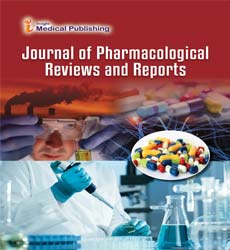Medication of Breast Cancer
Stauch Tim*
Department of Pharmacology, University of Cologne, Cologne City, Germany
- *Corresponding Author:
- Stauch Tim
Department of Pharmacology
University of Cologne
Cologne City, Germany
E-mail: stautim357@gmail.com
Received Date: October 6, 2021; Accepted Date: October 20, 2021; Published Date: October 27, 2021
Citation: Tim S (2021) Medication of Breast Cancer. J Pharmacol Rev Rep Vol.4 No.2:004.
Description
Breast cancer is the common term for several subtypes of breast tumors with different molecular and cellular origins and clinical behaviour. Most of them are epithelial tumors of ductal or lobular origin. Breast cancer is the most frequently diagnosed life-threatening cancer in women and the leading cause of cancer death in women worldwide.
Signs and symptoms
Early-stage breast cancer may be asymptomatic, and there is usually no pain or discomfort. If a lump is detected, the following may indicate the possible presence of breast cancer:
• Change in breast size or shape
• Skin depressions or skin changes
• Recent nipple inversion or change in skin or nipple abnormalities
• Single channel discharge, especially if there are blood spots
• Lumps in the armpit
Medication Summary
Adjuvant treatment for breast cancer includes radiation therapy and a variety of chemotherapeutic and biological agents. It is designed to treat micro metastatic disease (or breast cancer cells that have escaped from the breast and regional lymph nodes, but do not yet have proven and identifiable metastases). In patients receiving adjuvant aromatase inhibitor therapy for breast cancer who are at high risk for fracture, the monoclonal antibody denosumab or one of the bisphosphonates, zoledronic acid, and pamidronate may be added to the treatment regimen to increase the mass i.e., these active ingredients are administered in conjunction with a calcium and vitamin D supplement. Bevacizumab, a humanized monoclonal antibody that inhibits angiogenesis, has been approved for combination therapy in metastatic breast cancer. However, in November 2011, the US Food and Drug Administration (FDA) revoked approval for this indication after concluding that bevacizumab had not been shown to be safe and effective for this use.
In December 2013, Hoffmann-La Roche, manufacturer of Capecitabine (Xeloda), an oral drug used to treat breast and colon cancer, reported rare cases of life-threatening skin conditions such as Stevens-Johnson syndrome or toxic epidermal necrolysis. Signs and symptoms of severe skin reactions can include flu-like symptoms, fever, itching, mouth sores and burning eyes, and a painful red or purple rash that causes peeling. Fulvestrant (Faslodex) has been approved by the FDA for hormone receptor (HR) positive hormone receptor (HR) metastatic, locally advanced, or locally advanced breast cancer in endocrine-naive postmenopausal women. Approval is based on the results of the Phase III FALCON study; A total of 462 treatment-naive patients were randomized to 500 mg of fulvestrant on days 0, 14, 28, or 1 mg of anastrozole per day. Eligible patients had not previously received endocrine therapy despite prior chemotherapy. Data from FALCON showed that fulvestrant increased median progression-free survival (PFS) by 2.8 months compared to the aromatase inhibitor anastrozole. The overall response rate and the clinical benefit rate did not differ significantly between the groups. Fulvestrant resulted in a mean duration of response of 20 months compared to 13.2 months for anastrozole. The median duration of clinical benefit was 22.1 months for fulvestrant and 19.1 months for anastrozole. The expected duration of response also favoured fulvestrant, as did the expected duration of clinical benefit. Alpelisib (Piqray) is a phosphatidylinositol3 kinase (PI3K) inhibitor that was approved by the FDA in May 2019. It is indicated in combination with fulvestrant for the treatment of hormone receptor (HR) -positive men and postmenopausal women human epidermal growth factor 2 (HER2). Negative PIK3CAmuted advanced or metastatic breast cancer after progression into or after endocrine breast cancer therapy. Approval of alpelisib was supported by the SOLAR1 study (n=572). The results showed that the addition of alpelisib to fulvestrant significantly increased the median PFS (11 months) compared to fulvestrant alone (5.7 months) in patients whose tumors had a PIK3CA mutation.
Palbociclib and ribociclib are inhibitors of cyclin-dependent kinases (CDK) -4, 6 which, in combination with an aromatase inhibitor, are used as initial endocrine therapy for hormone receptor (HR) positive, receptor 2 receptor-positive postmenopausal women human epidermal growth (HER2)- negative advanced or metastatic sinuses are cancer. The approval of palbociclib for initial endocrine therapy in postmenopausal women was based on the phase II study (PALOMA1), in which median progression-free survival (PFS) was measured. The mean PFS was 10.2 months in the letrozole group and 20.2 months in the palbociclib plus letrozole group. The approval of palbociclib for advanced ER+/HER2 breast cancer in combination with fulvestrant in women (regardless of menopausal status) with disease progression after endocrine therapy is based on the PALOMA3 study (n=521). PFS was extended with palbociclib plus fulvestrant compared to fulvestrant alone (9.2 months vs. 3.8 months).
The approval of ribociclib was based on the results of the preliminary analysis of the pivotal phase 3 MONALEESA2 study in postmenopausal women who had not received prior systemic treatment for their advanced breast cancer. The study showed that ribociclib combined with the aromatase inhibitor letrozole reduced the risk of progression or death compared to letrozole alone. The median follow-up was 15.3 months. At 18 months, progression-free survival was 63% for 19.3 months in the ribociclib group and 42.2% for 14.7 months in the letrozole alone group. In patients with measurable disease at baseline, the overall response rates were 52.7% and 37.1%, respectively.
Open Access Journals
- Aquaculture & Veterinary Science
- Chemistry & Chemical Sciences
- Clinical Sciences
- Engineering
- General Science
- Genetics & Molecular Biology
- Health Care & Nursing
- Immunology & Microbiology
- Materials Science
- Mathematics & Physics
- Medical Sciences
- Neurology & Psychiatry
- Oncology & Cancer Science
- Pharmaceutical Sciences
